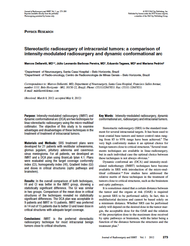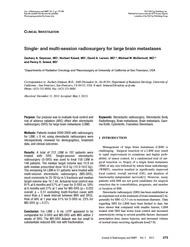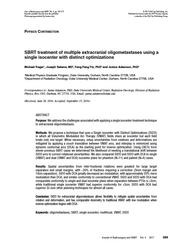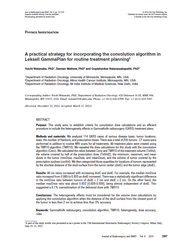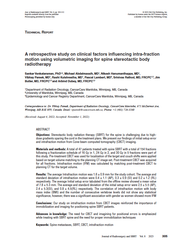- Home
- Journal Contents Downloads
- JRSBRT Downloads
- JRSBRT 8.4, p. 265-273
Product Description
Association between biologically effective dose and local control after stereotactic body radiotherapy for metastatic sarcoma
Eashwar Somasundaram, Timothy D. Smile, Ahmed Halima, James B. Broughman, Chandana A. Reddy, Shireen Parsai, Jacob G. Scott, Chirag Shah, Timothy Chan, Shauna Campbell, Lilyana Angelov, Peter M. Anderson, Stacy Zahler, Matteo Trucco, Stefanie M. Thomas, Shavaughn Johnson, Nathan Mesko, Lukas Nystrom, Dale Shepard, George Thomas Budd, Peng Qi, Anthony Magnelli, and Erin S Murphy
Introduction: Stereotactic body radiation therapy (SBRT) is increasingly utilized for patients with recurrent and metastatic sarcoma. SBRT affords the potential to overcome the relative radioresistance of sarcomas through delivery of a focused high biological effective dose (BED) as an alternative to invasive surgery. We report local control outcomes after metastatic sarcoma SBRT based on radiation dose and histology.
Methods: From our IRB-approved single-institution registry, all patients treated with SBRT for metastatic sarcoma between 2014 and 2020 were identified. Kaplan-Meier analysis was used to estimate local control and overall survival at 1 and 2 years. A receiver operating characteristic (ROC) curve was generated to determine optimal BED using an α/β ratio of 3. Local control was compared by SBRT dose using the BED cut point and evaluated by histology.
Results: Forty-two patients with a total of 138 lesions met inclusion criteria. Median imaging follow up was 7.73 months (range 0.5–35.0). Patients were heavily pre-treated with systemic therapy. Median SBRT prescription was 116.70 Gy BED (range 66.70–419.30). Desmoplastic small round cell tumor, Ewing sarcoma, rhabdomyosarcoma, and small round blue cell sarcomas were classified as radiosensitive (n = 63), and all other histologies were classified as radioresistant (n = 75). Local control for all lesions was 66.7% (95% CI, 56.6-78.5) at 1 year and 50.2% (95% CI, 38.2–66.1) at 2 years. Stratifying by histology, 1- and 2-year local control rates were 65.3% and 55.0%, respectively, for radiosensitive, and 68.6% and 44.5%, respectively, for radioresistant histologies (p = 0.49). The ROC cut point for BED was 95 Gy. Local control rates at 1- and 2-years were 75% and 61.6%, respectively, for lesions receiving >95 Gy BED, and 46.2% and 0%, respectively, for lesions receiving <95 Gy BED (p = 0.01). On subgroup analysis, local control by BED > 95 Gy was significant for radiosensitive histologies (p = 0.013), and trended toward significance for radioresistant histologies (p = 0.25).
Conclusion: There is a significant local control benefit for sarcoma SBRT when a BED > 95 Gy is used. Further investigation into the dose–response relationship is warranted to maximize the therapeutic index.
Keywords: Sarcoma, SBRT, dose, local control, biological effective dose
 Loading... Please wait...
Loading... Please wait...




